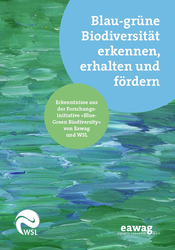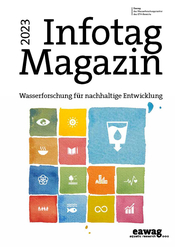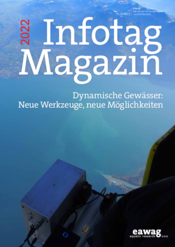Info Day
Eawag’s Info Day is devoted once a year to a current research topic. The event is aimed at anyone who is interested in the subject, and particularly experts working in the field in focus. The core of the event consists of lectures by Eawag’s resident experts, supplemented with specific contributions from external speakers. The Eawag Info Day serves as a forum for knowledge exchange between academia and practitioners, allowing plenty of time for plenary discussions as well as informal conversations.
Info Day 2025
Groundwater – utilising and protecting the resource drinking water
Thursday, 4 September 2025, AKADEMIE, Empa-Eawag Campus, Dübendorf
80% of Switzerland's drinking water comes from groundwater. Its protection is becoming increasingly difficult, especially in the densely utilised Central Plateau. New or newly focussed pollutants such as PFAS are raising new questions. Higher water temperatures and longer periods of drought as a result of climate change are exacerbating the situation. Can suppliers continue to supply consumers with virtually untreated groundwater under these circumstances? Why have problems that have long been recognised, such as nitrate pollution, still not really been solved? Eawag researchers will address such questions at the Info Day. They will present results and tools that support practitioners and administrators in safeguarding the quality and quantity of drinking water resources.
Lead: Dr Michael Berg
Course languages: German, French
Contact
Ilse Hildbrand
infotag@cluttereawag.ch
Program Info Day 2025 (German)
Das vollständige Programm mit Kurzbeschreibungen der Tagungsbeiträge ist ab April als Flyer verfügbar.
Die Sprache der Vorträge ist jeweils angegeben: Deutsch (D), Französisch (F). Es steht eine Simultanübersetzung zur Verfügung.
| ab 9:00 | Registrierung, Kaffee und Gipfeli |
| 09:30 | Begrüssung (D) Prof. Dr. Martin Ackermann, Direktor Eawag Umweltsystemwissenschaften, ETH Zürich und Fakultät ENAC, EPFL |
| 09:35 | Moderation (D) Dr. Sabine Hoffmann, Umweltsozialwissenschaften, Eawag |
| 09:40 | Einleitung: Grundwasser – die Ressource Trinkwasser nutzen und schützen (D) Dr. Michael Berg, Wasserressourcen & Trinkwasser, Eawag |
Blick in die Tiefe: Aktuelle Herausforderungen und Trends
| 09:50 | Grundwasserschutz – Herausforderungen und Lösungen (D) Dr. Michael Schärer, Abteilung Wasser, Bundesamt für Umwelt |
| 10:10 | Grundwasser in Zeiten des Klimawandels (D) Dr. Christian Moeck, Wasserressourcen & Trinkwasser, Eawag |
10:30 | Kaffeepause mit Ausstellung und Führungen Führungen: Einfluss von Wärmespeichern auf das Grundwasser (D, F) Anzahl Teilnehmende beschränkt, Anmeldung nach dem 26.8. möglich. Dr. Andres Velasquez Parra Wasserressourcen & Trinkwasser, Eawag Prof. Dr. Joaquin Jimenez-Martinez, Wasserressourcen & Trinkwasser, Eawag Robert Weber, Urban Energy Systems, Empa |
| 11:15 | Mit spitzer Feder: Augenzwinkernder Rückblick (D) Jonas Raeber, Live-Cartoonist |
| 11:20 | Mikroverunreinigungen: Menschliche Spuren im Grundwasser (D) Prof. Dr. Juliane Hollender, Umweltchemie, Eawag Biogeochemie und Schadstoffdynamik, ETH Zürich |
| 11:40 | KI-gestützte Nitratkartierung im Grundwasser (D) Prof. Dr. Lenny Winkel, Wasserressourcen & Trinkwasser, Eawag Biogeochemie und Schadstoffdynamik, ETH Zürich |
| 12:00 | Bedeutung und Erfassung der Biodiversität im Grundwasser (D) Dr. Mara Knüsel, Aquatische Ökologie, Eawag |
12:20 | Mittagspause |
Zwischen Nutzung und Schutz: Wege zu nachhaltigem Management
| 13:30 | Mit spitzer Feder: Augenzwinkernder Rückblick (D) Jonas Raeber, Live-Cartoonist |
| 13:35 | CH-GNet: Wissen vernetzen, Grundwasser schützen (D) Prof. Dr. Mario Schirmer, Wasserressourcen & Trinkwasser, Eawag |
| 13:55 | Plattform Grundwasserschutz - Unterstützung beim Vollzug des Grundwasserschutzes (F) Prof. Dr. Philip Brunner, Labor für hydrogeologische Prozesse, Universität Neuchâtel Prof. Dr. Daniel Hunkeler, Hydrochemie und Schadstoffe, Universität Neuchâtel |
| 14:15 | Urbane Untergrundstrukturen – Thermische Einflüsse und Potenziale (D) PD Dr. Jannis Epting, Umweltwissenschaften, Universität Basel |
14:35 | Kaffeepause mit Ausstellung und Führung (D, F) (Siehe Vormittag) |
| 15:20 | Mit spitzer Feder: Cartoons zu den Highlights des Tages (D) Jonas Raeber, Live-Cartoonist |
| 15:30 | Auf dem Podium – Diskussion und Austausch (D) Moderation und Teilnehmende noch offen |
| 16:00 | Schlusswort (D) Dr. Michael Berg, Wasserressourcen & Trinkwasser, Eawag |
| 16:15 | Apéro |
Info day archive
Here you will find the topics, the programme, the presentations and a picture gallery of the Info Days since 2011
The Info Day magazines of the last years
2024

Info Day Magazine Special 2024: Recognising, conserving & promoting blue-green biodiversity
2023

Info Day Magazine 2023: Aquatic research for sustainable development
2022

Info Day Magazine 2022: Dynamics of water - new tools, new opportunities

